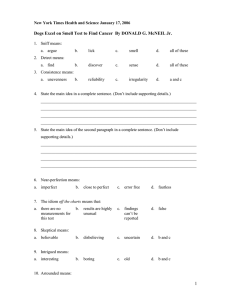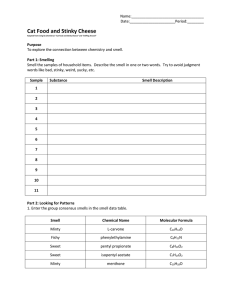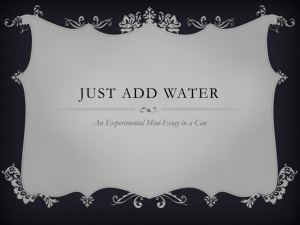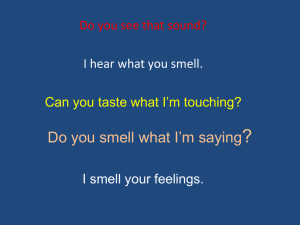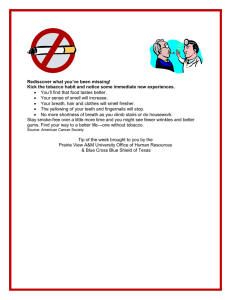READING TEST FOR BIOLOGY 2015
advertisement
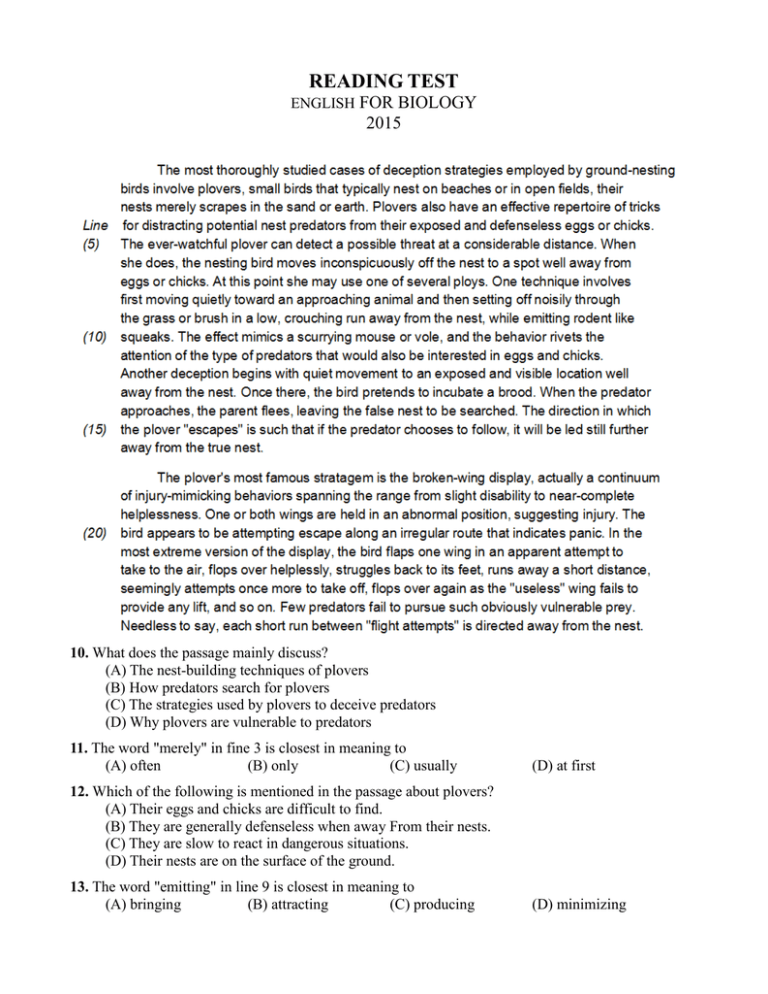
READING TEST
ENGLISH FOR BIOLOGY
2015
10. What does the passage mainly discuss?
(A) The nest-building techniques of plovers
(B) How predators search for plovers
(C) The strategies used by plovers to deceive predators
(D) Why plovers are vulnerable to predators
11. The word "merely" in fine 3 is closest in meaning to
(A) often
(B) only
(C) usually
(D) at first
12. Which of the following is mentioned in the passage about plovers?
(A) Their eggs and chicks are difficult to find.
(B) They are generally defenseless when away From their nests.
(C) They are slow to react in dangerous situations.
(D) Their nests are on the surface of the ground.
13. The word "emitting" in line 9 is closest in meaning to
(A) bringing
(B) attracting
(C) producing
(D) minimizing
14. In the deception technique described in paragraph 2 the plover tries to
(A) stay close to her nest
(B) attract the predator's
attention
(C) warn other plovers of danger
(D) frighten the approaching predator
15. The word "spanning" in line 18 is closest in meaning to
(A) covering
(B) selecting
(C) developing
(D) explaining
16. According to paragraph 4, which of the following aspects of the plover's behavior gives the
appearance that it is frightened?
(A) Abnormal body position
(B) Irregular escape route
(C) Unnatural wing movement
(D) Unusual amount of time away from the nest
17. The word "pursue" in line 24 is closest in meaning to
(A) catch
(B) notice
(C) defend
(D) chase
18. According to the passage, a female plover utilizes all of the following deception techniques
EXCEPT
(A) appearing to be injured
(B) sounding like another animal
(C) pretending to search for prey
(D) pretending to sit on her eggs
19. Which of the following best describes the organization of the passage?
(A) A description of the sequence of steps involved in plovers nest building
(B) A generalization about plover behavior followed by specific examples
(C) A comparison and contrast of the nesting behavior of plovers and other ground nesting birds
(D) A cause-and-effect analysis of the relationship between a prey and a predator
Questions 27-32
Reading Passage 111 has six paragraphs, A—F.
Choose the correct heading for each paragraph from the list of headings below.
Write the correct number, i—viii, in boxes 27-32 on your answer sheet.
List of Headings
i The difficulties of talking about smells
ii The role of smell in personal relationships
iii Future studies into smell
iv The relationship between the brain and the
nose
v The interpretation of smells as a factor in
defining groups
vi Why our sense of smell is not appreciated
vii Smell is our superior sense
viii The relationship between smell and feelings
27 Paragraph A
28 Paragraph B
29
30
31
32
Paragraph
Paragraph
Paragraph
Paragraph
C
D
E
F
The meaning and power of smell
The sense of smell, or olfaction, is powerful. Odours affect us on a physical, psychological and social
level. For the most part, however, we breathe in the aromas which surround us without being
consciously aware of their importance to us. It is only when the faculty of smell is impaired for some
reason that we begin to realise the essential role the sense of smell plays in our sense of well-being.
A A survey conducted by Anthony Synott at Montreal's Concordia University asked participants to
comment on how important smell was to them in their lives. It became apparent that smell can evoke
strong emotional responses. A scent associated with a good experience can bring a rush of joy, while a
foul odour or one associated with a bad memory may make us grimace with disgust. Respondents to the
survey noted that many of their olfactory likes and dislikes were based on emotional associations. Such
associations can be powerful enough so that odours that we would generally label unpleasant become
agreeable, and those that we would generally consider fragrant become disagreeable for particular
individuals. The perception of smell, therefore, consists not only of the sensation of the odours
themselves, but of the experiences and emotions associated with them.
B Odours are also essential cues in social bonding. One respondent to the survey believed that there is
no true emotional bonding without touching and smelling a loved one. In fact, infants recognise the
odours of their mothers soon after birth and adults can often identify their children or spouses by scent.
In one well-known test, women and men were able to distinguish by smell alone clothing worn by their
marriage partners from similar clothing worn by other people. Most of the subjects would probably
never have given much thought to odour as a cue for identifying family members before being involved
in the test, but as the experiment revealed, even when not consciously considered, smells register.
C In spite of its importance to our emotional and sensory lives, smell is probably the most undervalued
sense in many cultures. The reason often given for the low regard in which smell is held is that, in
comparison with its importance among animals, the human sense of smell is feeble and undeveloped.
While it is true that the olfactory powers of humans are nothing like as fine as those possessed by
certain animals, they are still remarkably acute. Our noses are able to recognise thousands of smells,
and to perceive odours which are present only in extremely small quantities.
D Smell, however, is a highly elusive phenomenon. Odours, unlike colours, for instance, cannot be
named in many languages because the specific vocabulary simply doesn't exist. 'It smells like ... ,' we
have to say when describing an odour, struggling to express our olfactory experience. Nor can odours
be recorded: there is no effective way to either capture or store them over time In the realm of olfaction,
we must make do with descriptions and recollections. This has implications for olfactory research.
E Most of the research on smell undertaken to date has been of a physical scientific nature. Significant
advances have been made in the understanding of the biological and chemical nature of olfaction, but
many fundamental questions have yet to be answered. Researchers have still to decide whether smell is
one sense or two - one responding to odours proper and the other registering odourless chemicals in the
air. Other unanswered questions are whether the nose is the only part of the body affected by odours,
and how smells can be measured objectively given the nonphysical components. Questions like these
mean that interest in the psychology of smell is inevitably set to play an increasingly important role for
researchers.
F However, smell is not simply a biological and psychological phenomenon. Smell is cultural, hence it
is a social and historical phenomenon. Odours are invested with cultural values: smells that are
considered to be offensive in some cultures may be perfectly acceptable in others. Therefore, our sense
of smell is a means of, and model for, interacting with the world. Different smells can provide us with
intimate and emotionally charged experiences and the value that we attach to these experiences is
interiorised by the members of society in a deeply personal way. Importantly, our commonly held
feelings about smells can help distinguish us from other cultures. The study of the cultural history of
smell is, therefore, in a very real sense, an investigation into the essence of human culture.
Questions 33-36
Choose the correct letter, A, B, C or D.
Write the correct letter in boxes 33-36 on your answer sheet.
33 According to the introduction, we become aware of the importance of smell when
A we discover a new smell.
B we experience a powerful smell.
C our ability to smell is damaged.
D we are surrounded by odours.
34 The experiment described in paragraph B
A shows how we make use of smell without realising it.
B demonstrates that family members have a similar smell.
C proves that a sense of smell is learnt.
D compares the sense of smell in males and females.
35 What is the writer doing in paragraph C?
A supporting other research
B making a proposal
C rejecting a common belief
D describing limitations
36 What does the writer suggest about the study of smell in the atmosphere in paragraph E?
A The measurement of smell is becoming more accurate.
B Researchers believe smell is a purely physical reaction.
C Most smells are inoffensive.
D Smell is yet to be defined.
Questions 37-40
Complete the sentences below.
Choose ONE WORD ONLY from the passage for each answer.
Write your answers in boxes 37-40 on your answer sheet.
37 Tests have shown that odours can help people recognise the belonging to their husbands and wives.
38 Certain linguistic groups may have difficulty describing smell because they lack the appropriate
39 The sense of smell may involve response to which do not smell, in addition to obvious odours.
40 Odours regarded as unpleasant in certain are not regarded as unpleasant in others.
Antarctic Penguins
Though penguins are assumed to be native to the South Pole, only four of the seventeen species have
evolved the survival adaptations necessary to live and breed in the Antarctic year round. The physical
features of the Adelie, Chinstrap, Gentoo, and Emperor penguins equip them to withstand the harshest
living conditions in the world. Besides these four species, there are a number of others, including the
yellow feathered Macaroni penguin and the King penguin that visit the Antarctic regularly but migrate
to warmer waters to breed. Penguins that live in Antarctica year round have a thermoregulation system
and a survival sense that allows them to live comfortably both on the ice and in the water.
In the dark days of winter, when the Antarctic sees virtually no sunlight, the penguins that remain on
the ice sheet sleep most of the day. To retain heat, penguins huddle in communities of up to 6,000 of
their own species. When it's time to create a nest, most penguins build up a pile of rocks on top of the
ice to place their eggs. The Emperor penguin, however, doesn't bother with a nest at all. The female
Emperor lays just one egg and gives it to the male to protect while she goes off for weeks to feed. The
male balances the egg on top of his feet, covering it with a small fold of skin called a brood patch. In
the huddle, the male penguins rotate regularly so that none of the penguins have to stay on the outside
of the circle exposed to the wind and cold for long periods of time. When it's time to take a turn on the
outer edge of the pack, the penguins tuck their feathers in and shiver. The movement provides enough
warmth until they can head back into the inner core and rest in the warmth. In order to reduce the cold
of the ice, penguins often put their weight on their heels and tails. Antarctic penguins also have
complex nasal passages that prevent 80 percent of their heat from leaving the body. When the sun is out,
the black dorsal plumage attracts its rays and penguins can stay warm enough to waddle or slide about
alone.
Antarctic penguins spend about 75 percent of their lives in the water. A number of survival adaptations
allow them to swim through water as cold as -2 degrees Celsius. In order to stay warm in these
temperatures, penguins have to keep moving. Though penguins don't fly in the air, they are often said to
fly through water. Instead of stopping each time they come up for air, they use a technique called
"porpoising," in which they leap up for a quick breath while swiftly moving forward: Unlike most birds
that have hollow bones for flight, penguins have evolved hard solid bones that keep them low in the
water. Antarctic penguins also have unique feathers that work similarly to a waterproof diving suit.
Tufts of down trap a layer of air within the feathers, preventing the water from penetrating the penguin's
skin. The pres 卢 sure of a deep dive releases this air, and a penguin has to rearrange the feathers
through a process called "preening." Penguins also have an amazing circulatory system, which in
extremely cold waters diverts blood from the flippers and legs to the heart.
While the harsh climate of the Antarctic doesn't threaten the survival of Antarctic penguins, overheating
can be a concern, and therefore, global warming is a threat to them. Temperate species have certain
physical features such as fewer feathers and less blubber to keep them cool on a hot day. African
penguins have bald patches on their legs and face where excess heat can be released. The blood vessels
in the penguin's skin dilate when the body begins to overheat, and the heat rises to the surface of the
body. Penguins who are built for cold winters of the Antarctic have other survival techniques for a
warm day, such as moving to shaded areas, or holding their fins out away from their bodies.
Questions 1-5
Classify the following facts as applying to:
A Antarctic penguins
B Temperature-area penguins
Write the appropriate letter, A or B, in boxes 1-5 on your answer sheet.
1 stand in large groups to keep warm
2 spend about three quarters of its time in the water
3 have feathers that keep cold water away from its skin
4 have areas of skin without feathers
5 have less blubber.
Questions 6-9
Complete each of the following sentences with information from the reading passage.
Write your answers in boxes 6-9 on your Answer Sheet. Write No MORE THAN THREE words for
each answer.
6 Most penguins use .............................. to build their nests.
7 While the male emperor penguin takes care of the egg, the female goes away to .............................. .
8 A .............................聽 is a piece of skin that the male emperor penguin uses to protect the egg.
9 Penguins protect their feet from the cold of the ice by standing on their ..............................
Questions 10-13
The article mentions many facts about penguins.
Which four of the following features are things that enable them to survive in very cold water?
Write the appropriate letters A-H in boxes 10-13 on your Answer Sheet.
A They move through the water very quickly.
B They hold their flippers away from their bodies. C They choose shady areas.
C When necessary, their blood moves away from the flippers and toward the heart.
D They breathe while still moving.
E The blood vessels in their skin dilate.
F They waddle and slide.
G Their feathers hold in a layer of air near the skin.
Questions 27-32
Reading Passage 117 has seven paragraphs, A—G.
Choose the correct heading for paragraphs B—G from the list of headings below.
Write the correct number, i—x, in boxes 27-32 on your answer sheet.
List of Headings
i The biological clock
ii Why dying is beneficial
iii The ageing process of men and women
iv Prolonging your life
v Limitations of life span
vi Modes of development of different species
vii A stable life span despite improvements
viii Energy consumption
ix Fundamental differences in ageing of objects and organisms
x Repair of genetic material
Example
Paragraph A
27 Paragraph
28 Paragraph
29 Paragraph
30 Paragraph
31 Paragraph
32 Paragraph
Answer
v
B
C
D
E
F
G
HOW DOES THE BIOLOGICAL CLOCK TICK?
A Our life span is restricted. Everyone accepts this as 'biologically' obvious. 'Nothing lives for ever!'
However, in this statement we think of artificially produced, technical objects, products which are
subjected to natural wear and tear during use. This leads to the result that at some time or other the
object stops working and is unusable ('death' in the biological sense). But are the wear and tear and loss
of function of technical objects and the death of living organisms really similar or comparable
B Our 'dead' products are 'static', closed systems. It is always the basic material which constitutes the
object and which, in the natural course of things, is wom down and becomes 'older'. Ageing in this case
must occur according to the laws of physical chemistry and of thermodynamics. Although the same law
holds for a living organism, the result of this law is not inexorable in the same way. At least as long as a
biological system has the ability to renew itself it could actually become older without ageing; an
organism is an open, dynamic system through which new material continuously flows. Destruction of
old material and formation of new material are thus in permanent dynamic equilibrium. The material of
which the organism is formed changes continuously. Thus our bodies continuously exchange old
substance for new, just like a spring which more or less maintains its form and movement, but in which
the water molecules are always different.
C Thus ageing and death should not be seen as inevitable, particularly as the organism possesses many
mechanisms for repair. It is not, in principle, necessary for a biological system to age and die.
Nevertheless, a restricted life span, ageing, and then death are basic characteristics of life. The reason
for this is easy to recognise: in nature, the existent organisms either adapt or are regularly replaced by
new types. Because of changes in the genetic material (mutations) these have new characteristics and in
the course of their individual lives they are tested for optimal or better adaptation to the environmental
conditions. Immortality would disturb this system — it needs room for new and better life. This is the
basic problem of evolution.
D Every organism has a life span which is highly characteristic. There are striking differences in life
span between different species, but within one species the parameter is relatively constant. For example,
the average duration of human life has hardly changed in thousands of years. Although more and more
people attain an advanced age as a result of developments in medical care and better nutrition, the
characteristic upper limit for most remains 80 years. A further argument against the simple wear and
tear theory is the observation that the time within which organisms age lies between a few days (even a
few hours for unicellular organisms) and several thousand years, as with mammoth trees.
E If a life span is a genetically determined biological characteristic, it is logically necessary to propose
the existence of an internal clock, which in some way measures and controls the ageing process and
which finally determines death as the last step in a fixed programme. Like the life span, the metabolic
rate has for different organisms a fixed mathematical relationship to the body mass. In comparison to
the life span this relationship is 'inverted': the larger the organism the lower its metabolic rate. Again
this relationship is valid not only for birds, but also, similarly on average within the systematic unit, for
all other organisms (plants, animals, unicellular organisms).
F Animals which behave 'frugally' with energy become particularly old, for example, crocodiles and
tortoises. Parrots and birds of prey are often held chained up. Thus they are not able to 'experience life'
and so they attain a high life span in captivity. Animals which save energy by hibernation or lethargy
(e.g. bats or hedgehogs) live much longer than those which are always active. The metabolic rate of
mice can be reduced by a very low consumption of food (hunger diet). They then may live twice as long
as their well fed comrades. Women become distinctly (about 10 per cent) older than men. If you
examine the metabolic rates of the two sexes you establish that the higher male metabolic rate roughly
accounts for the lower male life span. That means that they live life 'energetically' — more intensively,
but not for as long.
G It follows from the above that sparing use of energy reserves should tend to extend life. Extreme high
performance sports may lead to optimal cardiovascular performance, but they quite certainly do not
prolong life. Relaxation lowers metabolic rate, as does adequate sleep and in general an equable and
balanced personality. Each of as can develop his or her own 'energy saving programme' with a little
self-observation, critical self-control and, above all, logical consistency. Experience will show that to
live in this way not only increases the life span but is also very healthy. This final aspect should not be
forgotten.
Questions 33-36
Complete the notes below.
Choose NO MORE THAN TWO WORDS from the passage for each answer.
Write your answers in boxes 33-36 on your answer sheet.
• Objects age in accordance with principles of 33 ....................... and of 34 ...................................
• Through mutations, organisms can 35 ...................... better to the environment
• 36 ..................... would pose a serious problem for the theory of evolution
Questions 37-40
Do the following statements agree with the views of the writer in Reading Passage 3?
In boxes 37-40 on your answer sheet, write:
YES if the statement agrees with the views of the writer
NO if the statement contradicts the views of the writer
NOT GIVEN if it is impossible to say what the writer thinks about this
37 The wear and tear theory applies to both artificial objects and biological systems.
38 In principle, it is possible for a biological system to become older without ageing.
39 Within seven years, about 90 per cent of a human body is replaced as new.
40 Conserving energy may help to extend a human's life.

